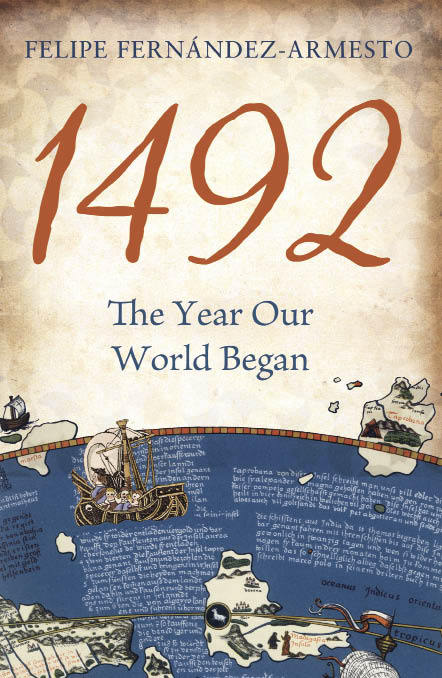Felipe Fernández-Armesto has a grand idea.
Felipe Fernández-Armesto has a grand idea. After the formation of separate continents about 150 million years ago, the world’s ‘cultures’ became progressively more ‘sundered’ and its ecosystems more divergent. Then, ‘with extraordinary suddenness’, in 1492 this long-standing pattern ‘went into reverse’: divergence ceased and ‘a new convergent era of the history of the planet began’.
Historians in the West have found it useful to break up the past into rough-and-ready segments — pre-history, followed by ancient, medieval and modern history — without jettisoning the understanding that history is seamless, a story of change and continuity whose events have both distant and immediate causes and effects. And there has long been a consensus that ‘modernity’ has its roots in the Renaissance, of which one vital element was overseas exploration and the discovery of new worlds symbolised by Columbus’ first voyage to America in 1492.
Fernández-Armesto wants to have his cake and eat it, too. He acknowledges the necessity of being ‘flexible about dates, ranging back and forth from what we now think of as 1492 into adjoining years, decades, and ages’, and he points out that ‘most of the transforming initiatives that helped to produce modernity’ came much earlier out of China — printing and paper money, gunpowder, the blast furnace, shipbuilding and navigational aids.
Nevertheless, ‘events in 1492 would make a decisive contribution towards transforming the planet — not just the human sphere but the entire environment in which human life is embedded — more profoundly and more enduringly than those of any previous single year.’
The assertion is more than bold. It is preposterous. To what comparative insignificance, for instance, does it consign the extinction of the dinosaurs 165 million years ago? Fernández-Armesto is not a biologist and he makes no attempt to substantiate his claim that 1492 was decisive for the world’s ecosystem. But he might have taken note of the evidence adduced by Gavin Menzies, in his 1421: The Year China Discovered the World (2002), that before the European ‘discovery’ of America cross-continental propagation of flora and fauna had taken place.
Fernández-Armesto provides no bibliography, but Menzies is absent from his footnotes, a striking omission given that Menzies, whose book is weightier and more carefully articulated than his own, argued that Columbus, Magellan and other navigators profited from maps of the world that derived from the worldwide voyages of Chinese fleets earlier in the century. Menzies’ conclusions have provoked controversy, but they touch Fernández-Armesto’s argument so nearly that simply to ignore them is inexplicable.
The first three events of 1492 in Fernández-Armesto’s list are Ferdinand and Isabella’s conquest of Granada and the expulsion of Islam from western Europe, the death of Sonni Ali the Great of Songhay and the perpetuation of Islam in sub- Saharan west Africa, and the expulsion of the Jews from Spain.
Making each of them a watershed event is not easy. After the conquest of Granada, Fernández-Armesto writes, ‘the habit of identifying Europe with Christendom went almost unchallenged until the late 20th century’. On the contrary, as Denys Hays demonstrated years ago, it was in the later Middle Ages that the idea of Europe came gradually to supplant that of Christendom. And Fernández-Armesto acknowledges, though only as a throw-away, that Islam remained entrenched in Ottoman-ruled Europe south of the Danube.
In Africa, it may be that Muhammad Touray’s victory over the Sonni in 1493 prevented the arrest of Islamic expansion beyond the edge of the Sahara. But was it ‘one of the great decisive battles of the world’? Fernández-Armesto makes no sustained argument to show that it had a lasting influence on the long rivalry between the Islamic empire and the West. Even in Africa, as he writes, ‘Christians never lost their advantage over Muslims in competing for sub-Saharan souls’. As for the Jews, he is forced to allow that Iberia was one of the last parts of western Europe — after England in 1291 and France in 1343 — to come round to expelling them.
Fernández-Armesto’s epilogue makes all the more baffling his tangling himself up in the knots of an all-encompassing thesis. He says that historians have ‘abandoned the search for long-term origins’, preferring to find the causes of things such as the fall of the Roman empire or the English Civil War in immediately antecedent crises. ‘It is a fallacy to assume that origins are always remote or that historical events are like big species — with long ancestries — or big plants with long roots.’ ‘What we used to call the longue durée has collapsed like a tidied-away telescope.’ Maybe so, maybe not. But if so, why try to locate the origins of our contemporary world in the events of a single year five centuries ago? It is all very strange.
And all so unnecessary. The stories stand up without scaffolding. The complexities of the reconquest of Granada, the brutality and scurrility of medieval anti-Semitism, the wealth and sophistication of Africa, the cosmopolitan breadth of Islamic tolerance, these Fernández-Armesto conveys with a breezy verve. He has written an excellent potted guide to a world — from Russia in its imperial infancy to the doomed civilisations of pre-Columbian America — in which the Middle Ages were waning and modernity was beckoning. Dressing it up adds nothing.






Comments